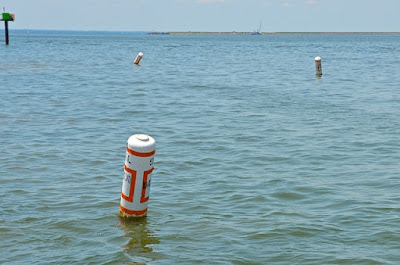
I am not sure what I thought about crabbers before spending a protracted time in their presence. There is a romantic vision of fisherman as a whole. You know, rugged individuals at battle with the sea, Mother Nature, and worse yet, the bureaucracy. And I admit that even with the onset of technology it is a strenuous life with much at stake, somewhat like farmers. And like farmers, there is the division between small and mammoth corporate enterprises.
The crabbers and oystermen (often one and the same) here on Chesapeake Bay tend towards the small, even the tiny end of the scale. They ply the waters in beat up fiberglass and aluminum skiffs, and pristine Chesapeake Bay dreadrises.
Carrie Rose left Island View Marina on a Sunday and passed through a couple of narrows. The first was Poplar Island Narrows, which was not quite as narrow as I expected but of course, in the narrowest spot, the markers became confusing. I assume I am a deep draft vessel. It has kept Carrie Rose off most shallows but in reality at 3.5 feet deep, we can get in most places. With Poplar Islands Narrows left behind, the next was Knapps Narrows. A manmade channel that created Tilghman Island.
The narrows and the island boast a fine collection of deadrise fishing boats along with the famous sail driven (with caveats, of course) skipjack fleet. To enter the narrows from the bay (west) side has more consequences — running aground — if the buoys, day marks, and I might add, additional local markers are not heeded. The other impediment to traversing the narrows is the bridge.

Bridges are represented on charts by type, and by horizontal and vertical clearance. The Knapps Narrows Bridge is a bascule bridge (like the Chicago River’s many bridges) with a horizontal clearance of 42 feet and a vertical clearance of 12 feet. Carrie Rose is both 11 feet wide and high, and should fit without difficulty.
A hard learned, or should I say earned, lesson is that when on the water it is better to be cautious and so, the VHR radio was switch from channel 16 to 13 and the bridge tender was hailed, “Knapps Narrows Bridge tender, Knapps Narrows Bridge tender this is the Carrie Rose”. He responded immediately. I pleaded my case to proceed without a bridge rising, though I would have had to lower my antennas. To which he responded, “Better safe than sorry, let me know when you get to green marker 5 and I will raise the bridge”.
I slowed to let the boats coming at me from the last bridge rising pass. In an entrance that is by nature narrow, it narrows even more due to shoaling. It is a tight squeeze most of the way to the bridge, which by the way, as the bridge tender informed me, was already open for a sailboat.


Overwhelming may be a bit too strong of a word, but the sight of the fishing fleet lined up perpendicular to the canal was striking. So many individuals relying on the bay’s crabs and oysters, it is indicative of the strength of the centuries old local culture. All I could do, in the back of my mind, was wish them and the bay well.

But where was I in this story, I got lost in the details. Maybe I am not too far off the mark. The crabbers are similar to farmers plowing a field. The difference is that the crabber’s field does not move horizontally. A line, marked by some type of buoy, with crab bait attached every three or four feet is strung out at varying lengths, and then slowly traversed in one direction. Once at the end, the boat scurries back to the buoy and begins the process once again: the line is gently raised from the bottom and any feasting crab is netted.
These boats are not subtle. They have large block, souped up V-8’s with two minimal mufflers directly off the engine pointing directly to the sky. As I watched, and listened, I thought of my urge to seek out new territory and experiences, even while contemplating the familiar.
I think this is where Carrie Rose comes in. As she has moved throughout eastern North America, the new has been tempered by her familiarity. I suppose it is the same for the fisherman and his craft. Every day on the water brings with it a different challenge.
The morning Carrie Rose spent anchored behind the sandy spit at the entrance of the appropriately named La Trappe Creek off the Choptank River; I watched a well used dreadrise plow its field from before 6AM until noon. SW to NE, NE to SW . . . relentless.
Obviously, the skipjacks have their appeal in the relative silence of their type. Choptank, oystermen, ringing bells of Michner's "Chesapeake" - enjoy the view!
ReplyDelete